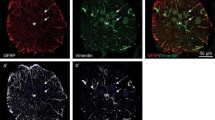Summary
In Periplaneta americana, SEM of abdominal nervous connectives revealed a rapid accumulation of haemocytes on the surface of the neural lamella within 24 h of selective disruption of the underlying neuroglia by ethidium bromide. After 4 days the neural lamella was effectively clear of adhering haemocytes, but showed characteristic “blisters”, which, it is postulated, represented the points of entry of the cells from the haemocoel into the underlying tissues. A notable subsequent feature was a substantial increase in the number of cells within repairing connectives. Initially, there was a marked asymmetry in their distribution, with significantly higher numbers of cells anterior to, and within, the lesion area. It seems likely that this polarity resulted from differential cell division within the connectives. The initial asymmetry disappeared after seven days. However, increased perineurial cell numbers were maintained in the lesion area after one month and were still apparent two months after selective glial disruption. There was no equivalent increase in cell numbers in the lesion zone of cultured cords or, in vivo, after injection of the DNA-scission drug, bleomycin, treatments which preclude haemocyte involvement. It is suggested that in the absence of haemocytes and with suppression of proliferation by endogenous cells, repair is achieved by redeployment or growth of adjacent, undamaged glia.
Similar content being viewed by others
References
Adrian EK, Schelper RL (1981) Microglia, monocytes and macrophages. In: Vidro EA, Federoff S (eds) Glial and Neuronal Cell Biology, 11th International Congress of Anatomy, Part A. A.R. Liss, Inc., New York, pp 113–124
Aguayo AJ, David S, Bray GM (1981) Influence of the glial environment on the elongation of axons after injury: transplantation studies in adult rodents. J Exp Biol 95:231–240
Brockes JP, Fryxell KJ, Lemke GE (1981) Studies on cultured Schwann cells: the induction of myelin synthesis and the control of their proliferation by a new growth factor. J Exp Biol 95:215–230
Bunge RP, Bunge MB (1983) Interrelationships between Schwann cell function and extracellular matrix production. Trends in Neurosciences 6:499–505
Howes EA, Leech CA (1985) Organ culture of adult cockroach CNS: ultrastructural and physiological characteristics. Tissue Cell 17:141–145
Howes EA, Smith PJS, Treherne JE (1986) Glial repair in the cultured central nervous system of an insect. Cell Tissue Res 247:111–120
Latov N, Nilaver G, Zimmermann EA, Johnson WG, Silverman A, Defendini R, Cote L (1979) Fibrillary astrocytes proliferate in response to brain injury. Dev Biol 72:381–384
Ludwin SK (1984) Proliferation of mature oligodendrocytes after trauma to the central nervous system. Nature 308:274–275
Morgese VJ, Elliott EJ, Muller KJ (1983) Microglial movement to sites of nerve lesion in the leech CNS. Brain Res 272:166–170
Nelson JW, Tinoco I Jr (1984) Intercalation of ethidium ion into DNA and RNA oligonucleotides. Biopolymers 23:213–233
Raff MC, Miller RH, Noble M (1983) A glial progenitor cell that develops in vitro into an astrocyte or an oligodendrocyte depending of culture medium. Nature 303:390–396
Schofield PK, Treherne JE (1984) Localization of the blood-brain barrier of an insect: electrical model and analyses. J Exp Biol 109:319–331
Schofield PK, Swales LS, Treherne JE (1984) Potentials associated with the blood-brain barrier of an insect: recording from identified neuroglia. J Exp Biol 109:307–318
Smith PJS, Howes EA (1984) Glial toxin effect on protein synthesis in an insect connective. J Cell Sci 70:83–92
Smith PJS, Howes EA (1986) Neural repair in an insect central nervous system: cell kinetics and proliferation after selective glial disruption. Cell Tissue Res 247:129–135
Smith PJS, Leech CA, Treherne JE (1984) Glial repair in an insect central nervous system: effects of selective glial disruption. J Neurosci 4 (11): 2698–2711
Smith PJS, Howes EA, Leech CA, Treherne JE (1986) Haemocyte involvement in the insect central nervous system after selective glial disruption. Cell Tissue Res 243:367–374
Treherne JE, Harrison JB, Treherne JM, Lane NJ (1984) Glial repair in an insect central nervous system: effects of surgical lesioning. J Neurosci 4(11): 2689–2697
Treherne JE, Howes EA, Leech CA, Smith PJS (1986) The effects of an anti-mytotic drug, bleomycin, on glial repair in an insect central nervous system. Cell Tissue Res 243:375–384
Author information
Authors and Affiliations
Rights and permissions
About this article
Cite this article
Treherne, J.E., Smith, P.J.S. & Edwards, H. Neural repair in an insect: cell recruitment and deployment following selective glial disruption. Cell Tissue Res. 247, 121–128 (1987). https://doi.org/10.1007/BF00216554
Accepted:
Issue Date:
DOI: https://doi.org/10.1007/BF00216554




